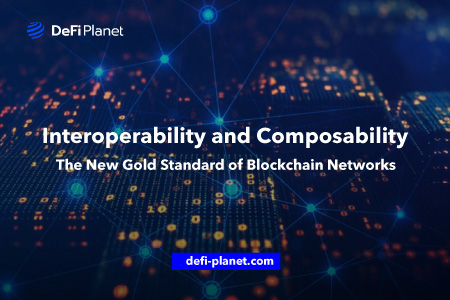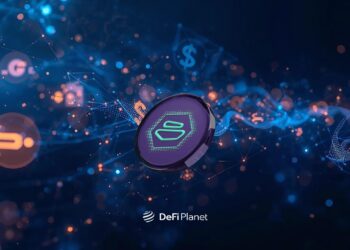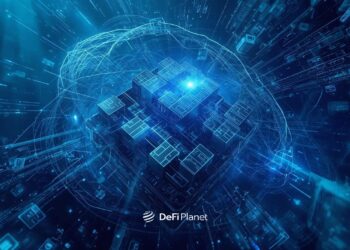The blockchain industry has grown exponentially over the last ten years. What began as a whitepaper in 2008 by Satoshi Nakamoto has evolved from the first L1-BTC blockchain to the arrival of the now dominant Ethereum, which captured the attention of crypto enthusiasts worldwide with its smart contract functionality.
The blockchain space has remarkably expanded to include other Layer 1 blockchains like Solana and Avalanche, Layer 2 blockchains like Arbitrum and Optimism, and multi-chain ecosystems like Polkadot.
Ethereum’s unique functionalities enable applications and protocols to interact seamlessly and combine to create new products. This capability allows developers and users to operate across multiple industries.
This article explores the concepts of interoperability and composability and their implications for blockchain networks, DeFi, and Web3.
TL;DR:
- Composability refers to the ability of decentralized applications (dApps) and DAOs to effectively clone and integrate one another (syntactic composability), as well as the interoperability of software components such as tokens and messages (morphological composability).
- Suppose a developer is working on a project that involves the transfer of high-value assets (such as DeFi). It often takes time for the protocols and applications to be battle-tested in order to reduce the risk of vulnerabilities. Composability expedites the app development process, encourages innovation and promotes interoperability.
- Interoperability refers to the ease with which messages and assets (fungible or non-fungible) can be transferred across blockchains, whereas composability refers to shared infrastructure or effective dApp cloning.
What is Blockchain Interoperability?
Blockchain adoption is currently limited due to industry fragmentation.
While there are numerous blockchain infrastructures on which to build, the problem is that the vast majority of these distributed networks are isolated and cannot interact with one another.
As a result, the majority of dApps’ resources are limited to the blockchains on which they are hosted.
Blockchain interoperability refers to the ability of independent distributed ledger networks to communicate with one another. In other words, interoperability is:
- The ability of blockchains to exchange and use data.
- The ability of a digital asset to move between two or more blockchains while retaining its uniqueness and state.
Interoperability between blockchains would allow dApps and digital assets to reach their full potential and enable the widespread application of exciting innovations across multiple platforms.
The Advantages of Interoperability in Blockchains
The functionalities of different blockchain networks vary. The average user is likely to use a variety of applications to meet their daily needs. This can also be seen in Web2, where a user may be on Facebook one moment and Youtube the next. If the two couldn’t be accessed easily and simultaneously, there’d be a lot of internet gridlock.
A Polkadot web wallet would be useless on a DeFi network that runs on the Ethereum blockchain. Suppose a user wants to create a new smart contract on Cardano but keeps most of their assets on the Avalanche network. This is currently impossible due to incompatibility between these networks. However, with the introduction of Web3 interoperability, a solution to this and many other issues will be possible.
At this point in the evolution of the crypto market, we can see how each project engages in a never-ending battle of numbers with the others in order to gain a larger market share (just as in the case of traditional networks).
The competition between social networks, which are closed networks for both developers and, in many cases, users, is an excellent example to help understand this issue.
Because there is no exchange of information between these sites, if Twitter introduces a new valuable feature, a Facebook user will be unable to benefit from it. It’s impossible to transfer your Twitter followers to Facebook (and vice versa). Also, your tweets cannot be viewed on Facebook.
Each platform is a closed circuit with no intention of creating a borderless ecosystem. All of these platforms compete for new customers, and once they have them, they will go to any length to keep them, including integrating all of the services that other platforms offer. This makes the entire development process slow and detrimental to creativity and productivity.
Unfortunately, this scenario is prevalent across blockchain networks, with most networks acting as islands disconnected from the others. This is the problem that interoperability seeks to address.
A nice example to help understand this issue is the competition between social networks, which are closed networks for both developers and, in many cases, users.
Since there is no contact between these sites, if Twitter introduces a new valuable feature, a Facebook user will be unable to profit from it. It is not possible to import one’s followers on Twitter to Facebook (and vice versa). Also, one’s Tweet cannot be viewed on Facebook.
Each platform is a closed circuit, with no intention of creating a borderless ecology. All of these platforms compete for new customers, and once they get them, they will do anything to keep them by integrating all of the services that other platforms have. This entire development and process are slow and detrimental to creativity and productivity.
Unfortunately, this scenario is becoming prevalent across blockchain networks, where each network is an island that does not connect with the others. This is the challenge that interoperability aims to solve.
What is Composability in Blockchain Technology?
The proliferation of decentralized technologies (i.e., Web3) has sparked a renewed interest in software composability. Since blockchain apps are based on open-source technology, they integrate well with other apps and can use existing libraries to create new user experiences.
Composability is simply the ability to combine different components to create new systems or outputs.
Composability in software development refers to developers combining or reusing existing software components to create new applications.
To better understand composability, let’s paint a vivid picture. Think of composable elements as Lego blocks. Legos are fun toys; each Lego block can be combined with another, allowing you to construct complex structures by combining different Legos.


“Composability” in Web3 refers to the ability of blockchain apps such as decentralized exchanges (DEXs), decentralized apps (dApps), and decentralized autonomous organizations (DAOs) to communicate with and collaborate.
In blockchain technology, composability means that developers can easily use and integrate code from other apps into their businesses. This is because smart contracts, which handle the logic of an app, are open-source and free for anyone to use. This significantly shortens the development cycle for decentralized applications (dApps).
Previously, developers had to create each feature of an application from scratch. Composability, on the other hand, allows developers to reuse code libraries from previously created dApps to create new ones. This reduces the amount of time spent writing lines of code.
DeFi is one application of blockchain technology that has benefited from composable software. SushiSwap, for example, built its decentralized exchange by cloning Uniswap‘s core and adding features like a governance token and liquidity mining. In DeFi, composability does for finance what broadband does for information.
Types of Blockchain Composability
Atomic Composability
The term “atomicity” refers to a concept in blockchain technology that allows for the consolidation of multiple transactions into a single transaction.
The atomicity principle states that for a transaction to be successful, all steps must be valid and achievable.
If even one step of the transaction fails, the entire transaction is considered unsuccessful.
Therefore, the idea that a single transaction can involve calls to multiple smart contracts constitutes atomic composability.
Syntactic Composability
The term “syntactic composability” refers to the ability to build systems out of smaller parts by implementing multiple modules that can be combined in various ways.
Syntactic composability thrives on three critical components (more on these later):
- Modularity
- Autonomy
- Discoverability
Morphological Composability
Although Ethereum was designed with composability in mind, not all dApps must have identical internal structures. Collaboration is essential in this case. Hence, several Ethereum Requests for Comment (ERFC) have been ratified as application-level standards for tokens, name registries, and wallet formats (ERC). The most well-known of these defines the parameters for a fungible token on the Ethereum network. It is called ERC20, which is also its acronym.
From a Web2 perspective, morphological composability has mind-blowing implications. For instance, DAO token holders can already vote on Snapshot and use Zodiac Reality to trigger a transaction from the DAO’s treasury to borrow $DAI from MakerDAO, pool the $DAI on Curve, deposit the resulting LP tokens into Convex, and earn trading fees plus $CRV and $CVX tokens.
How Does Blockchain Composability Work?
Smart contract composability is based on three principles: modularity, autonomy, and discoverability:
Modularity
This refers to the ability of individual components to complete a specific task. Every smart contract on Ethereum has a particular use case.
Autonomy
Composable components must be self-sufficient. In Ethereum, each smart contract runs independently and can work without the rest of the system.
Discoverability
If external contracts or software libraries are not publicly available, developers cannot access or incorporate them into applications. Smart contracts are made to be open source.
Benefits of Composability in Web3
Shorter Development Cycle
Composability reduces the amount of time and effort required by developers to create dApps.
If a smart contract solves one problem, other developers can use it to avoid dealing with the same issue again. This way, developers can create new dApps by using existing software libraries and adding more features.
Increased Creativity
Composability encourages creativity and experimentation because developers can reuse, change, duplicate, or merge open-source code to achieve the desired results.
As a result, development teams have more time to experiment with new features while spending less time working on core functionalities.
Improved User Experience
Users will have access to more features when dApps use external smart contracts than in a fragmented ecosystem where apps can’t communicate with one another.
The following scenario from arbitrage trading demonstrates the benefits of composability:
Suppose a token has a higher price on exchange X than on exchange Y; traders can profit from the price difference. This is only possible if the trader has sufficient funds to cover the transaction (i.e., buying the token from exchange Y and selling it on exchange X).
A flash loan may be ideal if the trader does not have enough funds to cover the transaction. Flash loans are highly technical, but the basic concept is that the trader can borrow assets (without collateral) and return them in a single transaction.
Back to the example, a trader can obtain a substantial flash loan, purchase tokens from exchange Y, sell them on exchange X, repay the capital and interest, and keep the profit all within the same transaction. This complex logic must make calls to multiple contracts simultaneously, which would be impossible if smart contracts can’t communicate with one another.
What is the Difference Between Composability and Interoperability?
Interoperability enables blockchains to communicate with one another despite differences in consensus, data availability, or block formation, while composability allows smart contracts to interact with other smart contracts on the same chain.
Interoperability refers to the efficient exchange of assets (fungible or non-fungible) and messages, whereas composability refers to the use of shared infrastructure in protocols.
Risks Associated With Interoperability and Composability
Combining different protocols and applications raises the risks associated with smart contracts. If one protocol contains a severe smart contract bug, the entire system may fail. As a result, it is crucial to exercise caution when investing large sums of money in any of these systems.
When these sectors become large enough, centralized insurance companies may consider offering smart contract insurance products and hiring smart contract auditors to analyze the code. This is similar to how some exchanges and custodians safeguard cryptocurrency.
In Conclusion,
- The interoperability of blockchains is crucial to the success of several sectors.
- It is indispensable in a future where businesses rely on greater collaboration and inclusivity.
- It would enable a more user-friendly experience, frictionless data sharing, simplified smart contract execution, and more opportunities for secure collaborations.
- A truly composable Web3 ecosystem requires improved smart contract security, increased collaboration among development teams, and increased standardization.
- Time will indeed tell if Web3 will continue to support composability.
If you would like to read more articles like this, visit DeFi Planet and follow us on Twitter, LinkedIn, Facebook, and Instagram.
“Take control of your crypto portfolio with MARKETS PRO, DeFi Planet’s suite of analytics tools.”





















